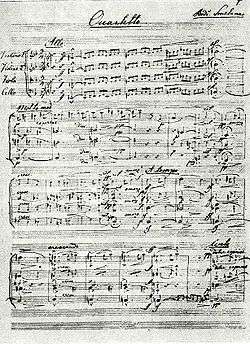String Quartet No. 2 (Smetana)

Bedřich Smetana's String Quartet No. 2 in D minor is a chamber composition for string quartet. It's Smetana's last quartet.
Background
In June 1882, after composing the monumental cycle Má vlast, operas Tajemství, Čertova stěna and other works, Smetana began thinking about the creation of his second string quartet. A month later he finished the first movement. In a letter to his friend Josef Srba the deaf and dejected composer presents the difficulties with the work, his misgivings and fears.[1] He continued very slowly, and the whole composition wasn't finished until 12 March 1883. (Several minor changes were made after the work was completed). Smetana attended the first non-public performance in Spring (April?[2]) 1883. The first public performance took place on 3 January 1884, at the Konvikt Hall in Prague. The work was played by Ferdinand Lachner, Julius Raušer, Josef Krehan and Alois Neruda.
The quartet was published posthumously, in 1889.
Structure
The composition consists of four movements:
Smetana said, that the second quartet takes up from where the first finished: "...after the catastrophe, it represents the turbulence of music in a person who had lost his hearing".[3] The musical construction and language are entirely new, unusual.[4] The composition was at first received by the part of listeners and critics with hesitation, and even with objections. However, thanks to many successful interpretations (Czech Quartet, Smetana Quartet, Janáček Quartet etc.) the quartet today belongs to the great values of Czech music history and culture.
Footnotes
References
- Bedřich Smetana: Quartetto II. Re minore. Score. Prague: Editio Supraphon, 1991. H 5550/7677. ISBN 80-7058-285-5
External links
| ||||||||||||||||||||||